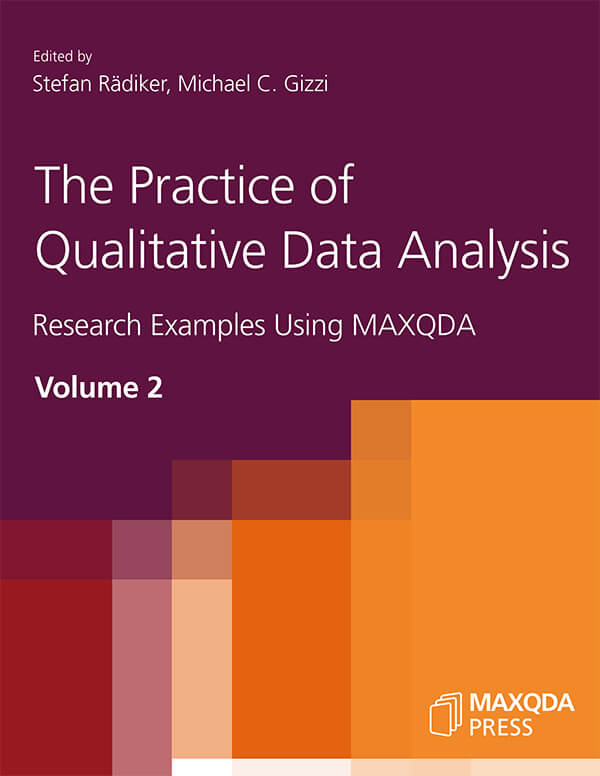Abstract
MAXQDA has been used to implement an interpretative approach to analyze interviews following Saša Bosančić’s Interpretative Subjectivation Analysis. This research approach integrates techniques from grounded theory and sequential analysis in a strongly theory-guided analysis. This chapter demonstrates a way to implement such an interpretative methodology with MAXQDA. Here, the focus lies on how sequential analysis, both as an individual researcher and in a group setting, can be implemented in MAXQDA. For this, the usage of in-documents memos and color coding was crucial. Linking codes to in-document memos helped to identify overarching patterns of interpretation and to arrive at a dense and theory-rich interpretation. Overall, the chapter shows that MAXQDA can be useful for very detailed and interpretative analysis just as well as for category-oriented approaches. Codes do not need to stand in the focus of working with MAXQDA, instead the software can be a great platform to integrate various steps of the research process.
Key MAXQDA features covered
![]() Color coding (highlight coding)
Color coding (highlight coding)
![]() In-document memos
In-document memos
![]() Document memos
Document memos
![]() Link codes to in-document memos
Link codes to in-document memos
![]() MAXMaps: Free map
MAXMaps: Free map
1. Introduction
With the onset of the 21st century, life, jobs, and identities became increasingly individualized. Patchwork biographies have become popular and societal blueprints of jobs, careers, and lifestyles have lost much of their normative power (Sennet, 2010). At the heart of this analysis lies the concept of the entrepreneurial self (Bröckling, 2007). According to this theory, policies are increasingly envisioning citizens as entrepreneurs of their own life using their skills, time, and other assets in a methodic or entrepreneurial way. A primary example of this concept are sole proprietors who work as one-person companies and usually sell their skills openly on the market.
My research focused on how established female entrepreneurs make meaning of their own situation and frame their identity in the dimensions of power, flexibility, gender, health, and qualification. Therefore, the following research questions guided the theory-driven analysis:
“What modes of subjectivation do female sole proprietors use in the contemporary working environment? How do they make meaning of their subjective position and what subject-positions do they use to identify or distinguish themselves?”
This project is used as an example for how a strongly theory-guided and interpretative methodology can be implemented with MAXQDA.
2. Data collection and methodological approach
To examine the research questions, four problem-centered interviews (Witzel, 2000) have been conducted with female sole proprietors from various branches of the economy. Saša Bosančić’s (2014, 2019) Interpretative Subjectivation Analysis (ISA) served as the primary methodological approach. This approach is rooted in the sociology of knowledge approach to discourse (SKAD) based on Keller (2011) and tries to breach the gap between a structuralist and an individualist perspective on discourse analysis and subjectification. For analyzing interviews, Bosančić suggests a combination of sequential analysis (Oevermann, 1979) and grounded theory (Glaser & Strauss, 1967). Sequential analysis is characterized by an extensive line-by-line interpretation of text where many different readings are created to uncover the internal logic of the case. Bosančić integrates this with a more coarse-grained analysis used in selective coding from grounded theory and arrives at three key stages, illustrated by Fig. 1.
While following this analysis layout, several key questions appeared regarding the specific implementation in MAXQDA:
- How to identify relevant segments for sequential analysis?
- How to implement sequential analysis both as a single researcher and as a group of analysists who meet face to face?
- How to reconstruct the internal logic of each case?
- How to create patterns of interpretation for the analysis based on this previous work?
- How to present the results?
For each of these five questions, a solution was implemented using functions of MAXQDA that will be explored in the following sections 3.1 to 3.5.
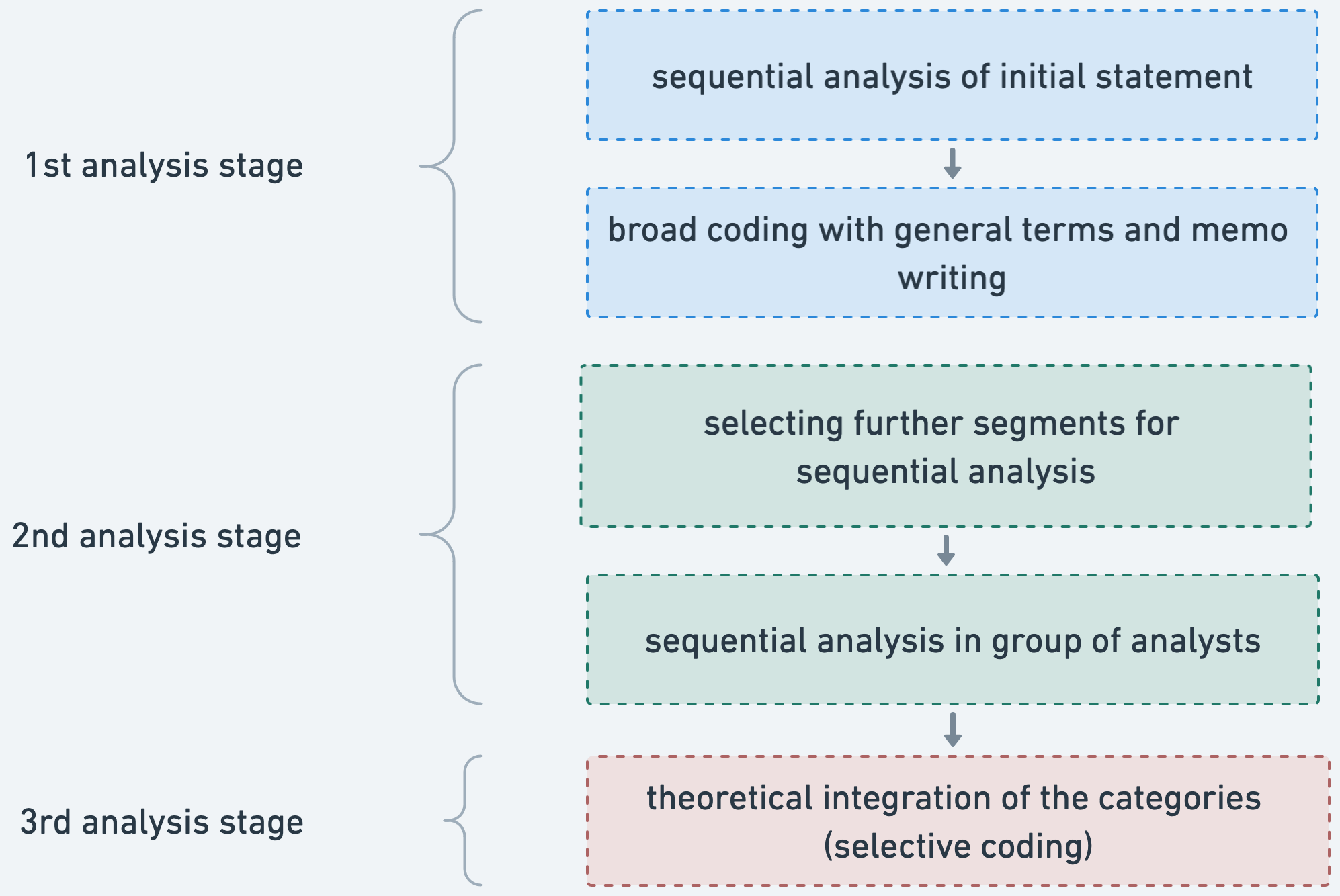
3. Implementing subjectivation analysis in MAXQDA
The four interviews were automatically transcribed using the transcription feature of Office 365 and manually corrected by the researcher. When importing the transcripts into MAXQDA, the transcripts were connected to the original audio files via timestamps so that the original audio statements could always be considered when interpreting a key statement. For sequential analysis, it is crucial to have the ability to reference brief text segments, including specific words, phrases, metaphors, etc., employed by the interviewees. Therefore, the numbering in Document Browser was altered from counting paragraphs to counting lines by right-clicking on the transcript text and selecting the option Convert to Line Numbered Text (Fig. 1).

3.1 Color coding: Identifying relevant statements for sequential analysis
Sequential analysis is a time-intensive method. Especially in group settings, one must be careful to make the best use of the valuable time of fellow researchers. For this reason, it is important to carefully consider which data to spend this time on. To pinpoint additional segments beyond the initial statement, the question emerged: how can the most relevant sections be identified?
In previous research projects, I found it very useful to use color codes in the initial work with text (Kuckartz & Rädiker, 2023), following a street-light logic:
- Red: unclear, must be looked up or verified.
- Yellow: relevant for the research question, will be properly coded later.
- Green: a key statement, will likely be quoted in the final report.
In this project, a more nuanced system seemed appropriate that considered both the internal logic of the case and the relationship between the case and the theoretical approach. The following color codes were used:
- Case-internal inconsistency (yellow): The segments seem to contradict what was said earlier or what is known about the interviewee.
- Personal perplexity (blue): The segment surprises the analyst on a personal or emotional level.
- Theoretical affirmation (green): The segment confirms or fits well with existing theories.
- Theoretical dissonance (red): The segment seems to contradict existing theories.
- Self-narrative (magenta): The person tells a story or anecdote that illustrates who they are.
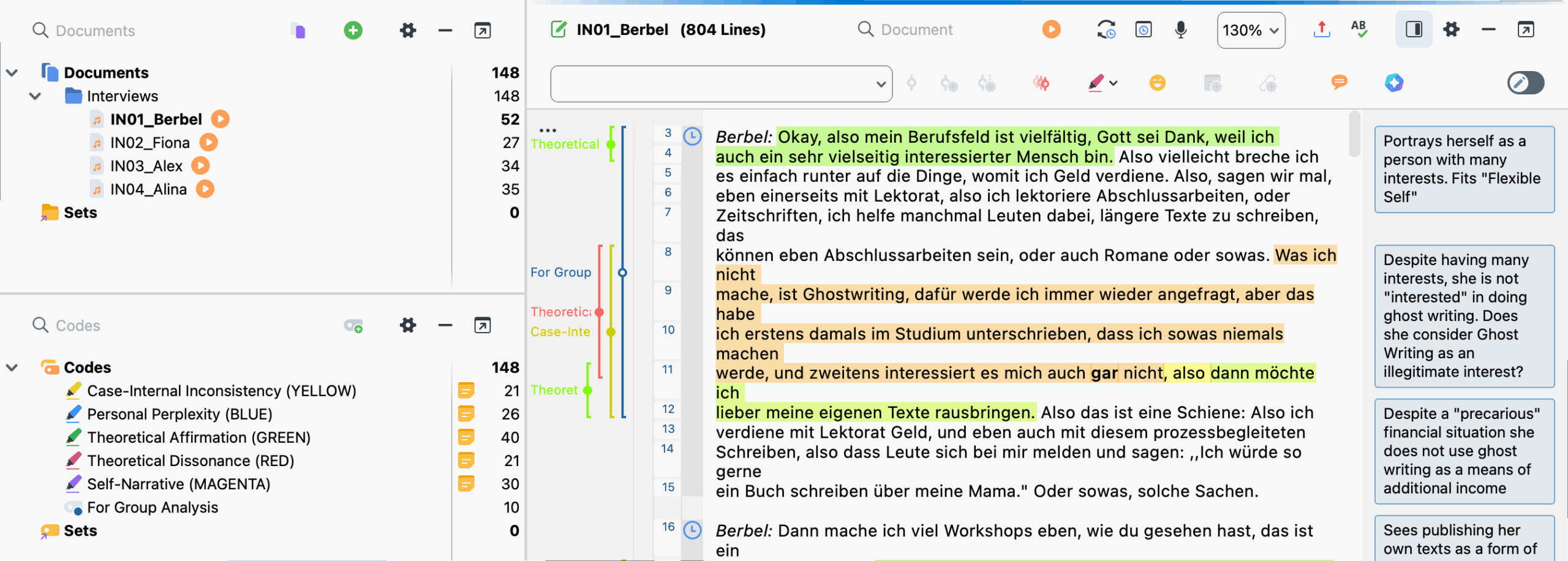
As illustrated in Fig. 3, I wrote a comment for each segment coded with a color code (visualized in blue boxes right to the text). The segments captured with color codes were then reviewed based on these written comments. The codes “Theoretical Dissonance” and “Case-internal Inconsistency” proved especially productive. After reviewing all color-coded segments, I selected a hand full of them and copied them into a code labeled with “For Group Analysis” (also illustrated in Fig. 3 at the bottom of the Code System). This continuous process of gathering important statements for group analysis accompanied my work of conducting sequential analysis alone as illustrated in the following section.
3.2 In-document memos: Sequential analysis of identified statements (alone and with an analysis group)

In-depth sequential interpretation of text lies at the heart of sequential analysis. To implement this, two components are key: first, conducting an in-depth interpretation of short segments of the text as a single researcher, and second, interpreting segments of the text collaboratively with a group of analysists in a face-to-face meeting. To document and retain in-depth interpretations, I used in-document memos as visualized in Fig. 4, which shows the interpretation of the initial statement “Alright, my professional field is diverse, thank God” in one interview. The in-document memo contains the original statement, various interpretations of it and any remaining questions. The text in bold and brackets was added later to indicate what became the dominant interpretation of this segment.
After I interpreted several segments alone and identified them by using color codes (see section 3.1), I asked a group of researchers to meet face-to-face and analyze the same sequence of segments. For this, the analysts began with one of the identified text segments from which they continued their analysis in a sequential order. Once the analysis of this sequence was completed, the other analysts moved on to the next segment that I had identified. In these group sessions, I took the role of taking notes and abstained from the discussion. All analysts received a paper copy of the interview that they used for discussion, while I recorded notes in MAXQDA using a new in-document memo (Fig. 5). These memos were given a red memo icon to distinguish them from those previously written alone, which I indicated using a blue memo icon.

After the analysis group finished discussing one segment, the in-document memo was reviewed together to make sure that it reflected the outcome of the discussion well. In my project, only two different readings (one by me, and one by the group) of the same sequence of segment were created. However, the same approach could be used to create readings with further analysis groups. For this step, MAXQDA served as an important note taking tool, that allowed enabling the convergence of various interpretations and the text.
3.3 Document memo: Writing detailed case portraits
In sequential analysis, it is important to reconstruct the internal structure of a case. Furthermore, it was key in this theory-guided approach to reflect on the case from a specific theoretical perspective. Therefore, writing extensive document memos that contained a detailed case portrait was a crucial step. The example shown in Fig. 6 is an abridged version of the memo for one case, which is in its full length 2,000 words long.
For writing these memos, a consistent structure was followed:
- Personal Motto. A short quote from the interview that summarizes the central attitude of the interviewee.
- Biography. An extensive note on the biography and living conditions of the interviewed person.
- Thematic Chronology. A thematic summary of the main contents following the order that occurs within the interview.
- Self-Image. A description of how the interviewed person talks about herself.
- Narrative framework: A description of the overarching story that the person tells through the interview.
- Subjective Theories. A bullet point list of the convictions or opinion that this person holds about other people or how the world operates.
- Case Structure Hypotheses. Any hypotheses that may explain the internal logic of the case.
- Open Questions. Any open or even unanswerable questions for this case.
- Topic Summaries. Short summaries focusing on each of the five guiding topics of the interview guidelines that were constructed based on theoretical assumptions.
- Theoretical interpretation. An interpretation reflecting the case based on the leading theories used in this approach.
These extensive memos allowed to create an in-depth interpretation of each case and to think clearly about the relationship of the case to the theory. This also ensured that the internal logic of the case and the story of the woman interviewed was not lost when focusing on single segments or interpretative patterns. The five topic summaries were later used to create a case comparison table with summaries.
![Fig. 6: Document memo of one of the interviews. “[…]” indicates omission from the original memo text which was much longer.](https://www.maxqda.com/wp/wp-content/uploads/sites/2/Fig-6.png)
3.4 Linking memos with codes: Creating interpretative patterns
Until this step, hardly any coding had been conducted, except for color coding. Most of the work was accomplished using in-document memos and document memos. After these steps, the key question that emerged was how to develop interpretative patterns. In accordance with Bosančić (2014, p. 272), an interpretative pattern can be seen not only as a pattern that structures a public discourse, but also as one that structures the self-identity and subject positions of individuals and that becomes visible in their actions and opinions.
For the task of identifying these patterns, the feature of linking codes to memos played a pivotal role. First, the extensive document memos (see section 3.3) were revisited and ideas for a code system were gathered in a free memo. Once this was done, preliminary codes were created to reflect the interpretative patterns and were defined via a code memo (Fig. 7). These codes were refined throughout the following process.

With these codes in mind all previously written in-document and document memos were revisited. Whenever a relevant pattern appeared in one of the memos, this memo was linked to the appropriate code by dragging the code from the Code System window and dropping it into the memo window (Fig. 8).
For example, a memo in which freelancing was described as the necessary mode of work because of once own personality traits was linked to the code “Freelancing as Fate” (Fig. 8). All memos that are linked to a corresponding code could easily be accessed via right-clicking on a code in the code system and selecting Linked Memos. After refining the code system, these codes were used to code all previously color-coded segments. For this, the Smart Coding Tool (available in the Codes menu tab) was used to easily assign the codes based on the segment comments written earlier (see section 3.1).
This extensive iterative process enabled me to reconstruct the patterns of interpretation in the form of a code system (Fig. 7), using the theory-rich memos and color codes. This elevated the data to a high level of abstraction and preserved the interpretations of the group of analysts and myself.
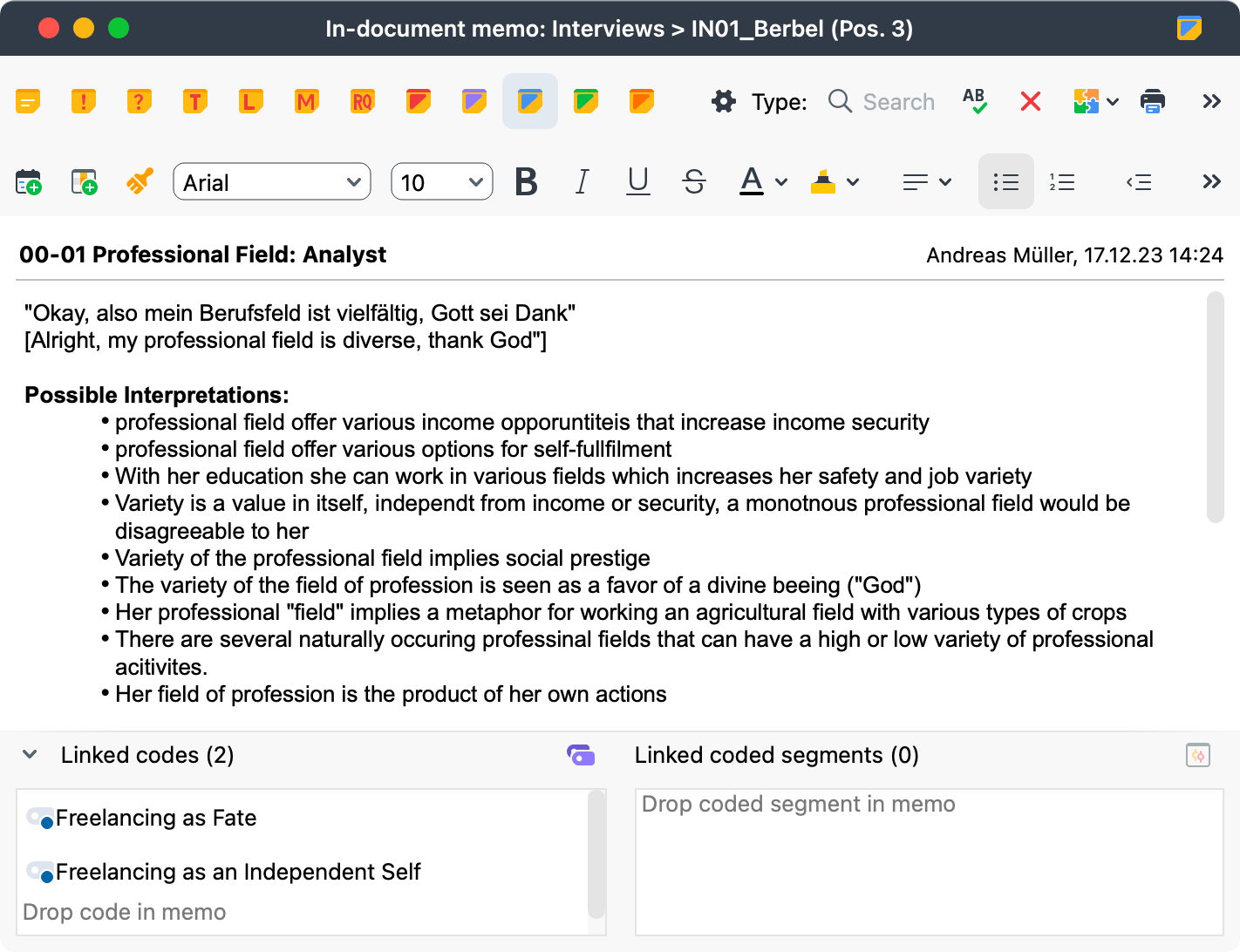
3.5 Table of summaries and MAXMaps: Presenting the results and creating the basis for a typology
Interpretative methods do not lend themselves easily to visualizing or even quantifying results. Therefore, I saw myself faced with the challenge of presenting and communicating my results well. To achieve this objective, I faced two key challenges: The first was to summarize the findings of the five topics that were already outlined in the interview guideline and to contrast these with the individual cases. The second challenge involved visualizing the patterns of interpretation that emerged throughout the analysis and connecting them to each respective interviewee.
Creating a case-comparison table with summaries
To address the first challenge, I condensed the results by creating a table with summaries for the five guiding topics of the interview guideline (Fig. 9). In the case portrait (see section 3.3), a summary of each of the five guiding topics had been written. These were transferred over into a table in Microsoft Word. Each summary was highly condensed to allow for a case-by-case comparison. The final table (Fig. 10) allowed me to compare the four cases based on the five central themes of the interview guideline. It became clear that there is no universal “type” in this data but that each woman positions herself on a spectrum of opinions.
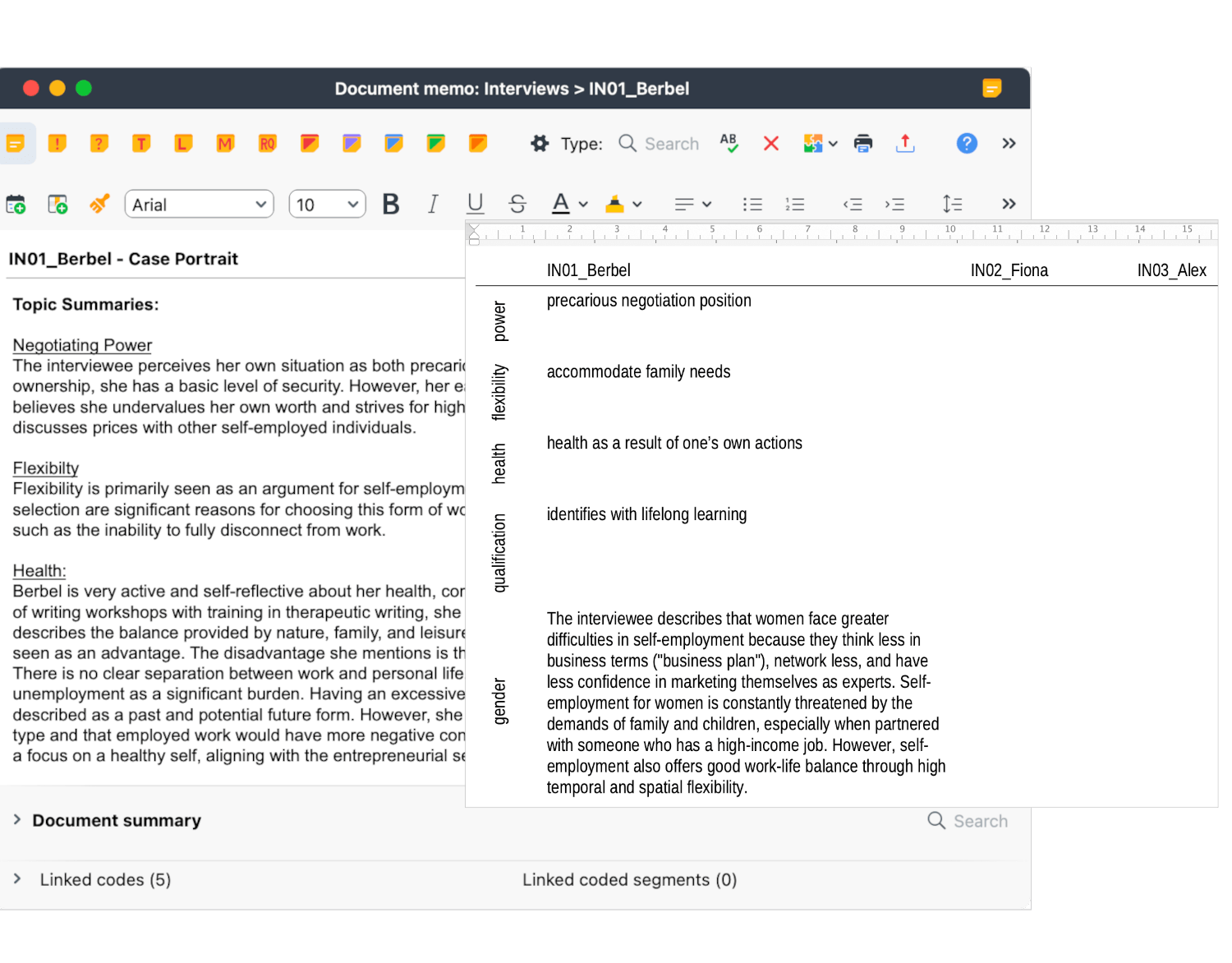

Visualizing the patterns of interpretation in MAXMaps
To achieve the second goal of visualizing the seven reconstructed patterns of interpretation I used MAXMaps. The seven interpretative patterns (see Fig. 6) form one general pattern, which is “Freelancing as an Independent Self,” indicating that the interviewees described freelancing as a form of self-fulfillment and part of their personal goals in life. The other six interpretative patterns were grouped into three pairs:
- “Distinction from Employees and Entrepreneurs”: They usually distinguished themselves both from dependent employees and from entrepreneurs who follow primarily economic interests.
- “Freelancing as Choice or Fate”: All interviewees described themselves both as making intentional choices towards freelancing and freelancing being their fate because of their inherent nature.
- “Self-induced and Structure Induced Employment Situation”: Regarding freelancing as an option for women they describe non-independent employment situations both as self-induced (lack of confidence, risk-aversion, lack of motivation) and as induced by the structure of society (gender expectations, parental duties, institutional barriers).
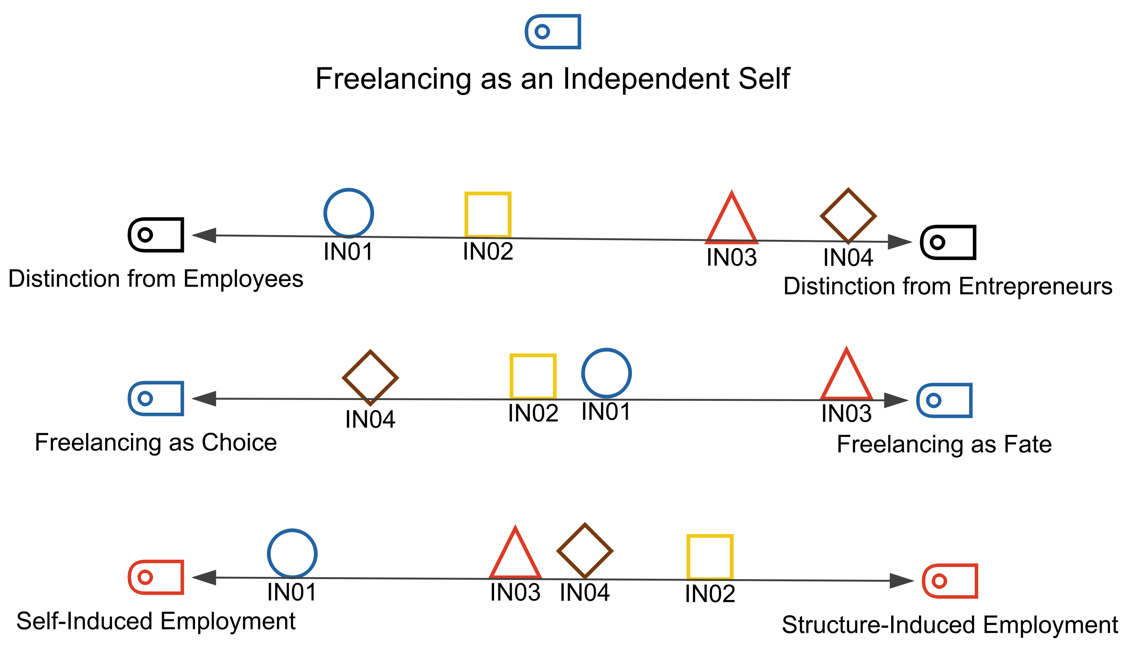
To visualize these results and relationships in a concept map (Fig. 11), I started Visual Tools > MAXMaps and inserted all seven codes into an empty map. I placed the pairs as poles of a spectrum that I connected with arrows, using Start > Link from the MAXMaps menu tab. Next, I utilized four shapes (circle, rectangle, triangle, diamond) to represent the four cases on this spectrum. Based on my document memos and by examining the codes with the interpretative patterns applied to each interview, I positioned each case on this spectrum.
For example, IN01 (blue circle) strongly identifies via her distinction from employees. Although she also mentions it, distinguishing herself from entrepreneurs is not crucial to her. Furthermore, she takes a medium position between freelancing as choice and fate. She describes freelancing both as her destiny and as a goal that she is constantly working for, which puts her in the middle of the spectrum. Finally, she sees the reason why many women are in regular employment situations as their own fault for not being determined enough. Although she also mentions structural barriers to self-employment for women, they play a minor role in her argument. This way, MAXMaps was of great help to answer the research question on how these female sole proprietors make meaning of their subjective position and how they distinguish themselves from others. This visualization was key to communicate my findings.
4. Overview of the analysis process
Fig. 12 illustrates and summarizes how the challenges for conducting subjectivation analysis were addressed by creating a workflow using several MAXQDA functions.

To conduct the sequential analysis, in-document memos were utilized to create a detailed interpretation of the initial section of an interview. In close connection with this step, color codes were employed to identify further relevant segments for subsequent in-depth analysis. Once the in-document memos and color codes were created for one document, a case portrait was written for every interview. This step was followed by another sequential analysis, this time in a group of researchers and implemented using in-document memos again. Once the group sessions were completed, the reconstruction of the patterns of interpretation was conducted by linking codes with memos and coding the initially identified and color-coded segments. Then, selective coding was implemented to rework and apply the patterns of interpretation to the entire material. Finally, the results were summarized and juxtaposed by topic for each case in a table and presented using MAXMaps.
5. Lessons learned
This chapter demonstrated how MAXQDA can be used to implement an interpretative, sequential, and theory-guided approach. Applying this approach using MAXQDA resulted in several lessons learned:
- One benefit of using MAXQDA as a tool for recording analytical notes is that it keeps these notes very close to the data. MAXQDA allowed me to keep an overview of interpretations of various analysis groups. Personally, I can highly recommend taking notes during a live, face-to-face analysis session within MAXQDA. This way, no insights were lost and writing extensive protocols from memory became unnecessary. Likewise, I was able to continue working right away with the interpretations provided by the other analysts.
- A systematic approach to use the color coding feature proved very beneficial for identifying relevant segments in this project. It can be challenging to keep a record of statements that caused initial surprise, which is often a sign that norms are violated, or expectations are not met. For this reason, it is crucial to keep track of such initial perplexity (based on the case internal logic, the theory, or personal experiences of the researcher) to make these implicit structures and norms visible. Using color codes in this way ensures preservation of these initial surprises that are often buried under an increasing familiarity with the data or poorly organized notes.
- To create the interpretative patterns, some less commonly used features of MAXQDA, such as the combination of in-document memos and linking codes to memos, were used. It proved fruitful to create a code system based mainly on memos.
- Overall, the chosen way of implementing the interpretative research approach proved to be highly effective in preserving continuously emerging insights and was straight forward enough to ensure purposeful use of time and resources.
Bibliography
Bröckling, U. (2007). Das unternehmerische Selbst: Soziologie einer Subjektivierungsform. Suhrkamp.
Bosančić, S. (2014). Arbeiter ohne Eigenschaften. Wiesbaden.
Bosančić, S. (2019). Die Forschungsperspektive der Interpretativen Subjektivierungsanalyse. In: Geimer, A., Amling, S., Bosančić, S. (Eds.) Subjekt und Subjektivierung (pp. 43–64). Springer, Wiesbaden. https://doi.org/10.1007/978-3-658-22313-7_3
Glaser, B. G., & A. L. Strauss. (1967). The discovery of grounded theory. Strategies for qualitative research. Aldine.
Kuckartz, U., & Rädiker, S. (2023). Qualitative content analysis: Methods, practice and software (2nd ed.). Sage.
Oevermann, U., Tilman A., & J. Krambeck. (1979). Die Methodologie einer „objektiven Hermeneutik“ und ihre allgemeine forschungslogische Bedeutung in den Sozialwissenschaften. In H. G. Soeffner (Ed.), Interpretative Verfahren in den Sozial- und Textwissenschaften (pp. 352–434). Metzler.
Keller, R. (2011). The sociology of knowledge approach to discourse (SKAD). Human Studies 34(1), 43–65. https://doi.org/10.1007/s10746-011-9175-z
Sennett, R. (2010). Der flexible Mensch. Die Kultur des neuen Kapitalismus. Berliner Taschenbuch Verlag.
Witzel, A. (2000). The problem-centered interview. Forum: Qualitative Social Research, 1(1) Art. 22. https://doi.org/10.17169/fqs-1.1.1132
About the author

Andreas Müller has been a professional MAXQDA trainer for over 5 years, and is a research and methods coach and contractual researcher. He is experienced in a wide array of qualitative methods and works with clients from diverse academic disciplines, including healthcare, educational sciences, and economics. Andreas specializes in the analysis of qualitative text and video data, as well as mixed methods data.
About the book
This article is part of the book The Practice of Qualitative Data Analysis published in 2023. Volume 2 which provides an additional nine case studies of real-world examples that illustrate how MAXQDA is used in actual research projects. Each chapter is organized to walk the reader through the research example, beginning with an introduction to the topic, a discussion of data collection and methodological approach, and a step-by-step description of how they used MAXQDA from start to finish, gaining insights into both efficient ways to use MAXQDA and innovative approaches they might not be aware of.

